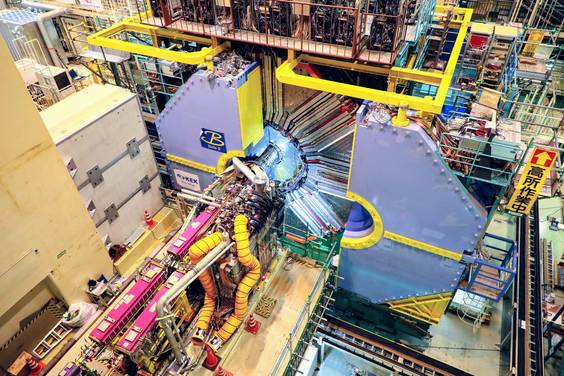23.03.2018
Japanese particle accelerator SuperKEKB kicks into new gear
Why is there so much more matter in the universe than antimatter? In order to clarify this fundamental question, researchers from the Universe Excellence Cluster are preparing an important experiment as part of an international research collaboration in Tsukuba, Japan. Following an eight-year conversion period, electrons and positrons will be brought to collision in the completely modernized "SuperKEKB" particle accelerator. In future, the Belle II detector, also modernized, will record the events with increased precision and is intended to shed new light on the understanding of the smallest particles of matter.
With the Belle II experiment, scientists aim to investigate a rare violation of symmetry – and clarify the question of why barely any antimatter exists in the today's universe. The decay of B-mesons plays a decisive role here. These particles are formed when electrons and positrons collide.
The new SuperKEKB accelerator produces 40x more collision events than its predecessor – and consequently substantially more data. To allow this data to be analyzed, the Belle detector is also undergoing modernization. In all, about 100 research establishments from 25 countries are working on Belle II. The Max Planck Institute (MPI) for Physics is involved in building the innermost detector. The Excellence Cluster Universe, the Max Planck Institute (MPI) for Physics, the Ludwig Maximilians Universität (LMU) and the Technical University of Munich (TUM) are involved in building the innermost detector and the development of the software for evaluating the data.
Excellence Cluster Universe involved in software and detector construction
“The decay point of the B mesons can be observed with the utmost precision using this pixel vertex detector”, explains Hans-Günther Moser of the Max Planck Institute for Physics. “This information is critical for identifying possible deviations in particle decay.” Software Coordinator Prof. Dr. Thomas Kuhr from LMU adds: "In addition, we are now in a position to process many times more data - we are talking about over 200 GBit/s with the innermost detector. In combination with improved algorithms we expect a very high statistical certainty in order to be able to reliably confirm or refute previously observed deviations from the standard model of particle physics".
On 21 March 2018, an electron beam was successfully introduced into the accelerator ring. It will be followed by a positron beam in early April. In parallel to this, the final preparations are under way for the first particle collision to take place in a few months' time.
A tandem in the search for new physics
The SuperKEKB accelerator and the Belle II detector form a tandem that scientists use to search for new physical processes beyond the standard model. They hope to find evidence of them in rare decays of elementary particles, such as b mesons, c quarks and tau leptons. "The successful commissioning of the accelerator and the Belle II experiment opens the door for unique scientific results and hopefully many surprises," says particle physicist Prof. Dr. Stephan Paul from TUM.
The SuperKEKB sets a new record with this modernization, achieving the greatest luminosity compared to other accelerators. This refers to the number of collisions per second and defined area. SuperKEKB also clearly outperforms its predecessor: 1,000 B/anti-B meson pairs are created per second, whereas KEKB achieved 25.
Related links:
Press release by the KEK research center
Press release by the Max Planck Institute for Physics
Contact:
Prof. Dr. Thomas Kuhr
Ludwig-Maximilians-Universität München
Software Coordinator Belle II
Exzellenzcluster Univers
Phone: +49 35831-7174
E-Mail: thomas.kuhr@lmu.de
Dr. Hans-Günther Moser
Max-Planck-Institut für Physik
Chair Institutional Board Belle II
Phone: +49 89 32354-248
E-Mail: moser@mpp.mpg.de






